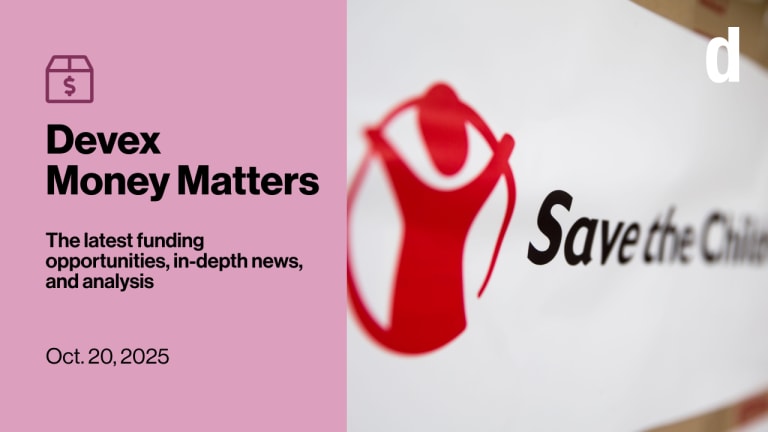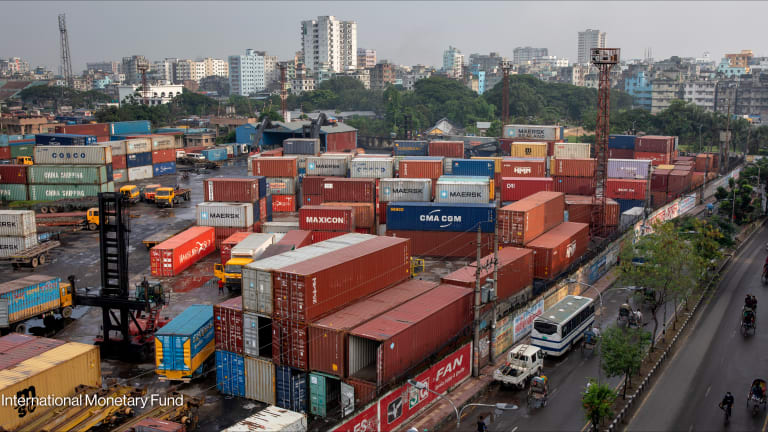Top aid donors to Afghanistan
Despite promises of long-term support for the Afghan reconstruction effort, donors have been cutting aid programs in Afghanistan. Devex ranks Afghanistan’s leading aid donors for 2014 and examines their programs and priorities.
In Afghanistan, a critical year of transition has begun. Afghans will elect a successor to longtime President Hamid Karzai in April, months ahead of the anticipated drawdown of NATO troops. More than 12 years into the Afghan reconstruction effort, foreign aid donors insist that they remain committed to Afghanistan’s development for the long-haul. “The success of the political transition is essential. But make no mistake — it’s not enough,” U.S. Secretary of State John Kerry said in November. “That’s why the United States firmly supports and will continue to support an Afghan-led peace and reconciliation effort as the surest way to end the violence and bring lasting stability to Afghanistan and the region.” At a conference in Tokyo two years ago, the international community pledged $16 billion in development assistance to Afghanistan through 2015. Despite widespread skepticism that Kabul has lived up to its own commitments to political and economic reform, aid donors are on track to meet their pledges, according to the Afghan Ministry of Finance. As Karzai — a well-known if still unpredictable quantity in world capitals — leaves office and the NATO presence winds down, analysts expect that aid flows to Afghanistan will decline in the years ahead. In the past few weeks alone, three of Afghanistan’s largest donors — the United States, Norway and Australia — have revealed major cuts to their Afghan aid programs. Yet wary of both the strategic and humanitarian consequences of an aid pullout, donors are also unlikely to disengage from Afghanistan’s development as they did back in the 1990s. Across the international community, there is broad agreement that Afghanistan’s fragile development gains, as well as the stability of the wider region, could be at risk unless Kabul can be assured of predictable and sustainable aid flows for the foreseeable future. The Afghan government relies on external financing for close to 100 percent of its budget. At the same time, foreign aid donors are also increasingly taking stock of the way they’ve been doing business in Afghanistan over the past 12 years. Most critically, donors — including the United States and the United Kingdom — are eager to channel more of their aid money directly through the Afghan government in a bid to promote local ownership and sustainability. To date, the international community has channeled the vast majority of its aid to Afghanistan through off-budget mechanisms that bypass the Afghan government. Below, Devex ranks Afghanistan’s leading aid donors for 2014 and examines their programs and priorities. We also looked at 2011 data from the Afghan Ministry of Finance to give an indicative breakdown of how much aid money is given directly to the government, via trust funds or through off-budget mechanisms. United States The Obama administration has pledged to sustain U.S. foreign aid flows to Afghanistan at under $2 billion through 2017 — now an unlikely proposition amid softening bipartisan support for the Afghan aid program in Washington. In the recently passed omnibus spending bill for the U.S. government, lawmakers capped U.S. civilian foreign aid spending in Afghanistan for fiscal 2014 at $1.1 billion or only roughly half of fiscal 2013 levels.The administration plans to direct 53 percent of its 2014 Afghan aid budget to democracy and governance programming — including pre-election support for Afghanistan’s election commission, civil society and media — and 23 percent to economic development. Japan At the 2012 Tokyo Conference on Afghanistan, the Japanese government pledged up to $3 billion in foreign aid to the country over the next five years. Through 2017, the Japanese aid program in Afghanistan will prioritize engagement in the following sectors: agriculture, infrastructure and human resource development. The largest Japanese aid project currently underway in Afghanistan is the construction of a 9.57 billion yen ($91 million) road between Kabul and Jalalabad. Germany Based on its forward-spending estimates, the German government’s foreign aid to Afghanistan in 2014 will reach $415 million. In November of last year, the German and Afghan governments agreed to pursue further development cooperation through 2017 in the areas of primary education, vocational training, energy, urban water supply, sustainable economic development and good governance. German development bank Kfw Entwicklungsbank is currently accepting bids for a project to extend Kabul’s water supply system. United Kingdom In fiscal 2014, the United Kingdom will spend 199.5 million pounds ($329 million) for the U.K. Department for International Development’s program in Afghanistan, one of the U.K. aid agency’s 28 priority countries. Officially committed to Afghanistan through 2017, DfID plans to direct 60 percent of its Afghanistan program budget this fiscal year to economic development and 25 percent to education programming. DfID’s single largest initiative in Afghanistan is the 36 million-pound Supporting Employment and Enterprise Development project. Asian Development Bank ADB has committed $219 million in assistance to Afghanistan in 2014. According to ADB’s recently released 2014-15 country operations plan for Afghanistan, over the next two years, the bank will allocate 57 percent of its grant financing for the energy sector, 38 percent for the transport sector, and 5 percent for agriculture and natural resources. ADB is currently soliciting proposals for its Energy Sector Development Investment program, the bank’s single largest initiative in Afghanistan. European Union Officially committed to its Afghan aid program through 2020, the European Union has pledged $207 million in assistance to Kabul in 2014. In Afghanistan, Brussels supports aid programming in three focal areas: governance and rule of law, agriculture and rural development, and health and social protection. Last year, the European Commission and the Afghan Ministry of Finance signed two financing agreements worth 185 million euros ($251 million) to support new programs in health and agriculture. EuropeAid is currently accepting bids for a feasibility study of the Panj-Amu River Basin Program. World Bank The World Bank has committed $181 million in financing for Afghanistan in 2014. The bank’s Afghan programming focuses on three key themes: building the legitimacy and capacity of institutions, equitable service delivery, and inclusive growth and jobs. Currently accepting bids for 10 of its projects in Afghanistan, the bank’s largest active program in the country is the $125 million Afghanistan Rural Access Project. In addition to financing its own projects, the World Bank administers the Afghanistan Reconstruction Trust Fund, the country’s biggest multidonor trust fund. Norway Citing concerns over Kabul’s record on corruption and gender-based violence, in October of last year, the Norwegian government slashed its 2014 development aid budget for Afghanistan. Afghanistan is now expected to receive 700 million kroner ($127 million) in Norwegian aid this fiscal year, down from Oslo’s earlier pledge of 750 million kroner. In February 2013, the Norwegian and Afghan governments signed a strategic partnership agreement that affirmed their commitment to development cooperation on education, good governance, rural development, human rights and anti-corruption initiatives through 2017. Australia Afghanistan hasn’t been spared from the sweeping cuts to Canberra’s fiscal 2014 foreign aid budget announced by Australia’s conservative government last week. Afghanistan is now slated to receive 131 million Australian dollars ($116 million) in aid this fiscal year, well below the then-Labor government’s commitment of AU$162 million. Health, education, economic development, governance and humanitarian relief are priority sectors for Australian development engagement in Afghanistan. Australia’s largest aid program in Afghanistan is the AU$76 million Development Assistance Facility for Afghanistan phase III. India The Indian government has budgeted 6.5 billion Indian rupees ($105 million) in grant assistance to Afghanistan in fiscal 2014. Afghanistan is the second-largest recipient of foreign aid from India, a fledgling yet ambitious donor that has focused much of its aid engagement on neighboring countries. In recent years, the bulk of India’s foreign aid spending in Afghanistan has been directed to large-scale infrastructure projects. A new parliament building in Kabul, a hydroelectric dam in Herat province and a road link to Iran’s Chabahar port are among the Indian government’s marquee aid projects in Afghanistan. Join the Devex community and gain access to more in-depth analysis, breaking news and business advice — and a host of other services — on international development, humanitarian aid and global health.
In Afghanistan, a critical year of transition has begun. Afghans will elect a successor to longtime President Hamid Karzai in April, months ahead of the anticipated drawdown of NATO troops.
More than 12 years into the Afghan reconstruction effort, foreign aid donors insist that they remain committed to Afghanistan’s development for the long-haul.
“The success of the political transition is essential. But make no mistake — it’s not enough,” U.S. Secretary of State John Kerry said in November. “That’s why the United States firmly supports and will continue to support an Afghan-led peace and reconciliation effort as the surest way to end the violence and bring lasting stability to Afghanistan and the region.”
This story is forDevex Promembers
Unlock this story now with a 15-day free trial of Devex Pro.
With a Devex Pro subscription you'll get access to deeper analysis and exclusive insights from our reporters and analysts.
Start my free trialRequest a group subscription Printing articles to share with others is a breach of our terms and conditions and copyright policy. Please use the sharing options on the left side of the article. Devex Pro members may share up to 10 articles per month using the Pro share tool ( ).
Lorenzo is a former contributing analyst for Devex. Previously Devex's senior analyst for development finance in Manila.








